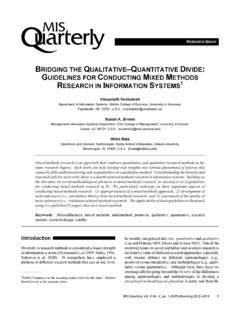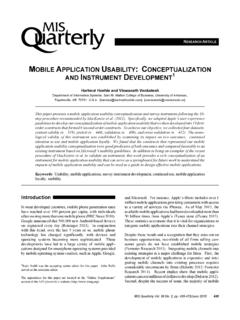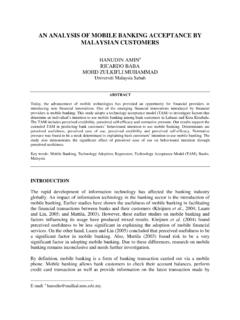Transcription of J ournal of the A ssociation for I nformation S ystems
1 J ournal of the A I S ssociation for nformation ystems Research Paper ISSN: 1536-9323 Unified Theory of acceptance and Use of Technology: A Synthesis and the Road Ahead Viswanath venkatesh Department of Information Systems, Walton College of Business, University of Arkansas James Y. L. Thong Department of Information Systems, Business Statistics and Operations Management, School of Business and Management, Hong Kong University of Science and Technology Xin Xu Department of Management and Marketing, Faculty of Business, The Hong Kong Polytechnic University Abstract.
2 The unified theory of acceptance and use of technology (UTAUT) is a little over a decade old and has been used extensively in information systems (IS) and other fields, as the large number of citations to the original paper that introduced the theory evidences. In this paper, we review and synthesize the IS literature on UTAUT from September 2003 until December 2014, perform a theoretical analysis of UTAUT and its extensions, and chart an agenda for research going forward. Based on Weber s (2012) framework of theory evaluation, we examined UTAUT and its extensions along two sets of quality dimensions; namely, the parts of a theory and the theory as a whole.
3 While our review identifies many merits to UTAUT, we also found that the progress related to this theory has hampered further theoretical development in research into technology acceptance and use. To chart an agenda for research that will enable significant future work, we analyze the theoretical contributions of UTAUT using Whetten s (2009) notion of cross-context theorizing. Our analysis reveals several limitations that lead us to propose a multi-level framework that can serve as the theoretical foundation for future research. Specifically, this framework integrates the notion of research context and cross-context theorizing with the theory evaluation framework to: 1) synthesize the existing UTAUT extensions across both the dimensions and the levels of the research context and 2) highlight promising research directions.
4 We conclude with recommendations for future UTAUT-related research using the proposed framework. Keywords: Theory Evaluation, Technology acceptance and Use, Unified Theory of acceptance and Use of Technology (UTAUT), Research Context, Literature Review, Multi-l evel Framework. Choon-Ling Sia was the accepting senior editor. This paper was submitted on October 3, 2013 and went through two revisions. Volume 17 Issue 5 pp. 328 376 May 2016 329 Unified Theory of acceptance and Use of Technology: A Synthesis and the Road Ahead 1 Introduction Research on individual acceptance and use of information technology (IT) is one of the most established and mature streams of information systems (IS) research ( venkatesh , Davis, & Morris, 2007).
5 There is also research on technology adoption by groups and organizations ( , Sarker & Valacich, 2010; Sarker, Valacich, & Sarker, 2005; Sia, Lee, Teo, & Wei, 2001; Sia, Teo, Tan, & Wei, 2004) that holds the premise that one must first use a technology before one can achieve desired outcomes, such as improvement in employee productivity and task/job performance in organizations. Researchers have proposed and tested several competing models ( , the technology acceptance model or TAM) and models based on the theory of planned behavior (TPB) to explain and predict user acceptance and use of IT.
6 About a decade ago, venkatesh , Morris, Davis, and Davis (2003) synthesized these models into the unified theory of acceptance and use of technology (UTAUT). UTAUT identifies four key factors ( , performance expectancy, effort expectancy, social influence, and facilitating conditions) and four moderators ( , age, gender, experience, and voluntariness) related to predicting behavioral intention to use a technology and actual technology use primarily in organizational contexts. According to UTAUT, performance expectancy, effort expectancy, and social influence were theorized and found to influence behavioral intention to use a technology, while behavioral intention and facilitating conditions determine technology use.
7 Moreover, various combinations of the four moderators were theorized and found to moderate various UTAUT relationships. In longitudinal field studies of employees acceptance of technology, UTAUT explained 77 percent of the variance in behavioral intention to use a technology and 52 percent of the variance in technology use. Recently, venkatesh , Thong, and Xu (2012) proposed and tested UTAUT2, which incorporates new constructs ( , hedonic motivation, price value, and habit) that focus on new theoretical mechanisms (see Bagozzi, 2007; Benbasat & Barki, 2007; venkatesh et al.)
8 , 2007) in a consumer context. UTAUT2 explained 74 percent of the variance in consumers behavioral intention to use a technology and 52 percent of the variance in consumers technology use. Although research considers UTAUT to have reached its practical limit of explaining individual technology acceptance and use decisions in organizations ( venkatesh et al., 2003), UTAUT-based research has thrived ( venkatesh et al., 2012). Specifically, research has applied UTAUT as is, applied it with other theories, or extended it to study a variety of technologies in both organizational and non-organizational settings.
9 The continued growth of UTAUT-based research has partly arisen due to the proliferation and diffusion of new ITs such as enterprise systems (Sykes, 2015; Sykes, venkatesh , & Johnson, 2014), collaboration technology in knowledge-intensive firms ( , Brown, Dennis, & venkatesh , 2010), mobile Internet for consumers ( , Thong, venkatesh , Xu, Hong, & Tam, 2011; venkatesh et al., 2012), agile IS (Hong, Thong, Chasalow, & Dhillon, 2011), e-government for citizens (Chan, Thong, venkatesh , Brown, Hu, & Tam, 2010), and health IS in the healthcare industry ( , venkatesh , Sykes, & Zhang, 2011) in organizations and society.
10 IT has penetrated almost every aspect of the society, and various individuals in various contexts now use it. While the past decade has generated a large number of new ITs and associated studies based on UTAUT, in analyzing the literature, we found that the IS discipline is at a crossroads regarding what the future holds for UTAUT and, in particular, the possible theoretical contributions from further research into technology acceptance and use. We believe that systematically evaluating the contributions of the existing UTAUT-based studies can reveal the utility of UTAUT and the limitations of existing UTAUT-based research from which one can then develop a new framework of technology acceptance and use with a view toward charting promising future research directions.





